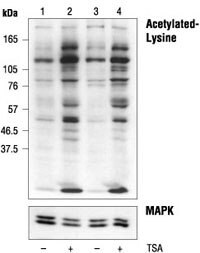ST1027
Anti-Acetylated Lysine Rabbit pAb
liquid, Calbiochem®
Sign Into View Organizational & Contract Pricing
All Photos(1)
About This Item
UNSPSC Code:
12352203
NACRES:
NA.43
Recommended Products
biological source
rabbit
Quality Level
antibody form
affinity isolated antibody
antibody product type
primary antibodies
clone
polyclonal
form
liquid
does not contain
preservative
species reactivity (predicted by homology)
all
manufacturer/tradename
Calbiochem®
storage condition
OK to freeze
avoid repeated freeze/thaw cycles
isotype
IgG
shipped in
wet ice
storage temp.
−20°C
target post-translational modification
acetylation (Lys)
General description
Anti-Acetylated Lysine, rabbit polyclonal antibody that recognizes acetylated lysine in UV-treated HEK293 cells. It is validated for ELISA, Western blotting, immunoprecipitation, & paraffin sections.
Immunoaffinity purified rabbit polyclonal antibody. Recognizes acetylated lysine-containing proteins.
Recognizes acetylated lysine residues in UV-treated HEK293 cells.
Immunogen
synthetic acetylated-lysine
Application

ELISA (1:1000)
Immunoblotting (1:1000)
Immunoprecipitation (1:100)
Paraffin Sections (1:50)
Warning
Toxicity: Standard Handling (A)
Analysis Note
Positive Control
HEK293 cells treated with UV
HEK293 cells treated with UV
Other Notes
Yu, X., et al. 2002. J. Natl. Cancer Inst.94, 504.
Mal, A., et al. 2001. EMBO J.20, 1739.
Sano, Y. and Ishii, S. 2001. J. Biol. Chem.276, 3674.
Mal, A., et al. 2001. EMBO J.20, 1739.
Sano, Y. and Ishii, S. 2001. J. Biol. Chem.276, 3674.
Legal Information
CALBIOCHEM is a registered trademark of Merck KGaA, Darmstadt, Germany
Not finding the right product?
Try our Product Selector Tool.
Storage Class Code
10 - Combustible liquids
WGK
WGK 2
Certificates of Analysis (COA)
Search for Certificates of Analysis (COA) by entering the products Lot/Batch Number. Lot and Batch Numbers can be found on a product’s label following the words ‘Lot’ or ‘Batch’.
Already Own This Product?
Find documentation for the products that you have recently purchased in the Document Library.
Jeong-Hoon Kim et al.
Genes & development, 24(24), 2766-2771 (2010-12-17)
The positive link between the SWI/SNF and the Gcn5 histone acetyltransferase in transcriptional activation has been well described. Here we report an inhibitory role for Gcn5 in SWI/SNF targeting. We demonstrate that Gcn5-containing complexes directly acetylate the Snf2 subunit of
Chao Yang et al.
The Journal of biological chemistry, 287(42), 34917-34926 (2012-08-25)
The MYST family of histone acetyltransferases (HATs) plays critical roles in diverse cellular processes, such as the epigenetic regulation of gene expression. Lysine autoacetylation of the MYST HATs has recently received considerable attention. Nonetheless, the mechanism and function of the
Ling Cai et al.
Cell reports, 4(6), 1063-1071 (2013-09-17)
Ribosome biogenesis requires an enormous commitment of energy and resources in growing cells. In budding yeast, the transcriptional coactivator Ifh1p is an essential regulator of ribosomal protein (RP) gene transcription. Here, we report that Ifh1p is dynamically acetylated and phosphorylated
Chao Yang et al.
PloS one, 7(3), e32886-e32886 (2012-04-04)
The 60-kDa HIV-Tat interactive protein (Tip60) is a key member of the MYST family of histone acetyltransferases (HATs) that plays critical roles in multiple cellular processes. We report here that Tip60 undergoes autoacetylation at several lysine residues, including a key
Amélie Feytout et al.
Molecular and cellular biology, 31(8), 1771-1786 (2011-02-09)
In budding yeast and humans, cohesion establishment during S phase requires the acetyltransferase Eco1/Esco1-2, which acetylates the cohesin subunit Smc3 on two conserved lysine residues. Whether Smc3 is the sole Eco1/Esco1-2 effector and how Smc3 acetylation promotes cohesion are unknown.
Our team of scientists has experience in all areas of research including Life Science, Material Science, Chemical Synthesis, Chromatography, Analytical and many others.
Contact Technical Service








